Best Roomba Alternatives
Roomba were the first to launch a commercially viable robot vacuum in 2002 (source) and have been top of the pack ever since. But as you’d expect from high quality devices, they come with a high price tag too.
If you’re after a cheaper Roomba alternative, or just want to get more bang for your buck, then you’ve come to the right place. In this guide, we’ll share the best alternatives to Roomba’s three popular robot vacuums, the i3+, i7+ and s9+.
Roomba i3 Alternatives
The Roomba i3+ is a really great budget vacuum that has many of the cleaning components of the higher spec i7 model which means it provides a really great clean. It has Roomba’s patented dual roller extractor which performs exceptionally well at getting smaller particles from deep in the carpet.
It does lack some of the smarter features such as mapping your home which is why it’s a more affordable option. This means that you cannot select schedules for individual rooms or change the frequency per room. It also lacks recharge-and-resume so will end it’s current task once the battery has run out.
Plus, there’s the self-emptying Clean Base which can empty your vacuum up to 30 times before you need to worry about emptying it yourself.
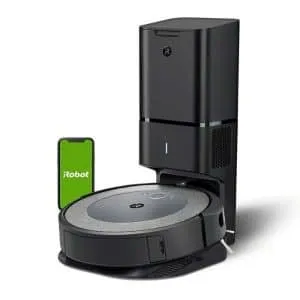
Roomba i3+ with Clean Base
Here is a run down of the key Roomba i3 and i3+ features:
Cheapest Roomba (compared to i7 and s9)
Control via Roomba Home app
Option to add self-emptying Clean Base (i3+)
Does not have mapping
Does not have no go zones
No recharge and resume
The i3+ hasn’t yet made it to the UK, so while you wait here are a few Roomba i3 alternatives:
- BEST i3 ALTERNATIVE: Roborock E4
- RUNNER UP: Eufy 15C MAX
- BUDGET PICK: Coredy R750
Below is some more information about each of these alternatives:
Best i3 Alternative: Roborock E4
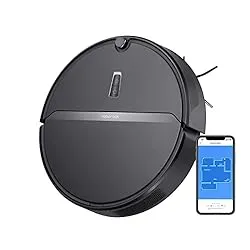
High battery life (3 hours)
Logical cleaning routes gives good coverage
Lots of suction power
No mapping so you cannot create virtual barriers or set room cleaning
Struggles with some thresholds such as thick rugs
The E-series is Roborock’s budget end range of vacuums and the E4 is their newest iteration of this. It has 2,000 pA of suction power which allows it to pick up most small and large debris with no problems.
Much like the i3, it doesn’t have mapping capability as Roborock left out their usual lidar unit, however it gyroscope and OpticEye motion tracking system are able to remember where it has already been and where is left to go during a clean. As there is no mapping, you can’t set no-go zones or choose which rooms to clean.
It does pull in some features of the other vacuums, including Roborock’s biggest 5,200 mA battery capacity and their 640ml dust bin. There is also the option to add on a mop (sold separately).
Runner Up: Eufy 15C MAX

Picks up all sizes of debris with 2000pA of suction
BoostIQ increases suction when required
Alexa and Google Home support (although basic)
No mapping so you cannot create virtual barriers or set room cleaning
Cleaning pattern is random
Eufy have positioned themselves as a value for money offering, they specialize in producing budget vacuums that are reliable and put in a few of the high-end features.
The 15C MAX is a lot cheaper than the Roomba i3+, and as you’d expect this means there are some areas that it doesn’t perform as well. One of these is navigation. Although the i3+ doesn’t map your home, it still navigates in straight lines as it remembers where it has been. Conversely the Eufy tends to zip around in random directions until it’s completed the room.
It’s one of the slimmest robot vacuums currently on the market which is perfect for getting under furniture but for this reason it isn’t particularly great at getting over thresholds due to the low clearance height.
It has 2000 pA of suction which is powerful for its price range, although it’s prone to getting pet hair stuck in the bristles, something which the i3 doesn’t do. It has BoostIQ which is similar to the Roombas Dirt Detect feature where it can automatically adjust the suction power to compensate for excess dirt on the floor.
Budget Pick: Coredy R750

Budget price robot vacuum
Does well with hair considering it’s price
Can also be used as a mop (but not at the same time as vacuum)
Uses random zig zagging to get around
Occasionally scatters larger debris
For lower tier devices, the Coredy R750 packs a punch. It has 1600 pA of suction power which is about average for its price, however it also has boost intellect which is their version of dirt detect to automatically change the suction when carpet is detected.
It’s a 2-in-1 robot vacuum and mop, although it cannot do both simultaneously as you need to fit the water tank, so we’d recommend just sticking to one or the other.
Although this is still firmly in the budget category, it’s one of Coredy’s top devices and the only one to feature an app for scheduling and with both Google Home and Alexa support.
As it cannot map a floor plan, it uses a random path to clean your room. It occasionally scatters larger debris, but by the end of the run it seems to pick up all sizes of dirt. The Coredy has a combo brush that means hair tangles are less likely than other products mentioned here such as the Eufy.
Roomba i7 Alternatives
Next, we have the mid-tier Roomba i7. Although it is mid-tier for Roomba compared to the i3 and s9, it’s still expensive relative to some of the alternative robot vacuums on the market.
The i7 has the same cleaning ability as the i3, only it has iadapt 3.0 as opposed to the 2.0 version in the i3. This means it has full mapping capabilities so you can build a floor plan of your home and create room-by-room cleaning schedules or instruct the robot to clean a certain room.
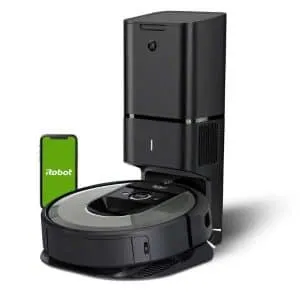
Key features of the Roomba i7 and i7+:
Has smart mapping using visual cameras
Room by room cleaning schedules
Option to add self-emptying Clean Base (i7+)
Create no go zones
Premium metallic finish
Here are three cheaper alternatives to the Roomba i7 that have many of the same features:
- BEST i7 ALTERNATIVE: Ecovacs Deebot OZMO 920
- RUNNER UP: Roborock S5 MAX
- WORTH A MENTION: Dyson 360 Heurist
We’ve put together a little more detail on each of these devices below:
Best i7 Alternative: Ecovacs Deebot OZMO 920

Laser mapping of your home to create an interactive map
Dual front brushes do a good job of collecting debris
Simultaneous vacuum and mopping
Cheaper than the i7
The Ecovacs Deebot OZMO 920 is our top alternative to the iRobot Roomba i7, it launched about 12 months later and has panned out to be a better robot vacuum at a cheaper price point – what’s not to love.
The high grip wheels are suspended independently, they can easily navigate across rugs or thresholds in your home. Although it doesn’t have anything like the self-emptying base, it is a 2-in-1 vacuum and mop which can do both simultaneously making it ideal if you have hardwood or vinyl floors.
Like their other high-end vacuums, Ecovacs have used their Smart Navi 3.0 laser mapping technology in the OZMO 920 which allows it to create an interactive map of your home for zoned cleaning and virtual boundaries. The app is very straight forward, and the user interface rivals the iRobot Home app which is considered a best in class.
As well as controlling from the app, there is both Alexa and Google Home integration so you can use voice commands.
Runner Up: Roborock S5 MAX
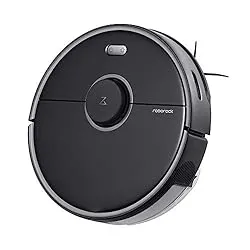
Uses Lidar to map your home
2,500 pA of suction is well above average
3 hours of battery life
Mopping function with high levels of control
Does not have a self emptying base
The S5 MAX is not the latest in the series S-series but it’s still stands up as an incredibly great robot. For most of it’s specs, it’s very comparable to the Ecovacs although just falls behind with cleaning performance.
As for navigation, the Roborock S5 can also map the layout of your home, only it uses Lidar as opposed to the vSLAM technology in the Roomba i7, this tends to be even more accurate. Just like the Roomba, once the floor plan has been created, you can customise it in the app and use this for setting room-by-room cleaning or virtual no-go zones.
It will literally pick up anything, from excellent deep cleaning of tiny particles, to making light work of larger debris. It has a huge 2,500pA of suction power (compared to 1,800 in the i7) and has an industry leading 3 hours of battery life due to its 5,200 mAh battery capacity.
All those features and we still haven’t even mentioned the mopping ability which is very well implemented with a large water tank and high precise control over how much water is used. Clearly, the one element it’s missing that the i7 has is the self-emptying Clean Base, so this is the main compromise.
Worth a Mention: Dyson 360 Heurist
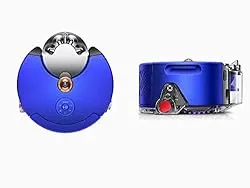
vSLAM navigation like the Roomba i7
Tan-style wheels navigate over thresholds well
Zoned cleaning and virtual no-go zones in the app
Does not adapt to floor types, this must be set up manually in the app
Taller design struggles with some low furniture
The Dyson 360 Heurist is their second-generation robot vacuum cleaner that uses their cyclone technology found in their traditional vacuum. If you want a device from a household name in vacuums then this one performs highly.
There are some similarities between the 360 Heurist and the Roomba i7, for example, they both use the same vSLAM style of navigation and feature mapping, room-by-room cleaning and virtual no-go zones.
However, The Dyson isn’t quite as clever as the i7 as it doesn’t automatically detect the floor types and the extractor brush has bristles like a traditional vacuum so it’s very prone to getting hairs tangled.
Its slimmer design means it can navigate much more easily around obstacles such as chairs and tables, however the trade off is that it’s taller so may not fit under lower furniture. Dyson have opted for tank style wheels that allow it to easily manoeuvre over thresholds and to get across thick rugs.
Roomba S9 Alternatives
Finally, we’ll look at some alternatives to the Roomba S9, iRobot’s most premium Roomba with all the bells and whistles.
This robot has had some serious upgrades to give it a better cleaning ability, especially when it comes to edge cleaning thanks to the D-shape and Perfect Edge technology. As with the i7, the robot has full mapping capabilities to set a floor plan of your home that can be managed in the iRobot Home app.
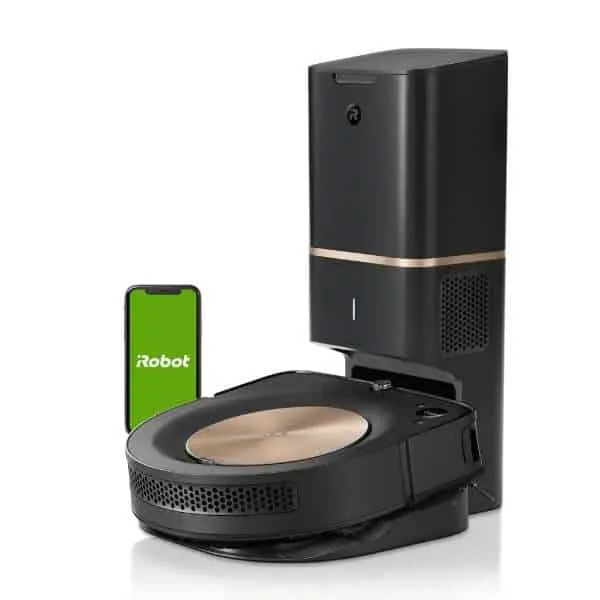
Roomba S9+ with Clean Base
Key features of the Roomba S9 and S9+:
D-shape for better for edges
More suction for better cleaning
Wider coverage
Has smart mapping
120-minute run time
Create no go zones
S9+ has self-emptying base
However, all of these great features mean the S9 costs far more than any other robot vacuum currently on the market in the UK. So, we’ve pulled together these Roomba S9 alternatives with a price tag that’s a little easier to swallow:
- BEST S9 ALTERNATIVE: Roborock S6 MAX V
- RUNNER UP: Ecovacs Deebot OZMO T8
- BEST VALUE: Neato D7
Below are the full details of each vacuum and how they compare to the S9 and S9+.
Best S9 Alternative: Roborock S6 MAX V
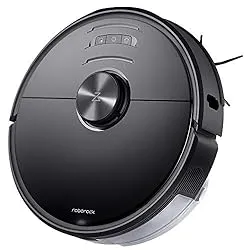
Combines laser and camera navigation for high accurate mapping
Market leading 2,500 pA of suction
Mopping capability with option to set no-mop or no-vacuum zones
No self emptying base
We already shared the S5 MAX earlier, but the S6 MAX V is the very latest top-end vacuum from Roborock and a great alternative to the i7. We’d go as far to say it’s one of the most advanced robot vacuums on the market in the UK right now.
Whereas most robot vacuums will have either Lidar or vSLAM navigation, this vacuum combines the two in order to get the best of both worlds. The Lidar uses lasers to provide highly accurate mapping of your home, then the cameras have advanced algorithms to recognise what’s in its path and avoid any objects.
It’s not just intelligent, it’s also a powerful cleaner thanks to suction power of 2,500 pA that far exceeds most currently on the market, and an integrated mop with 297ml water tank. You can choose which areas to vacuum, which to mop and which to do both.
Runner Up: Ecovacs Deebot OZMO T8 AVIV

Highly intelligent with AI to detect and navigate around obstacles
3 hour battery life
Self emptying base coming to the UK soon
High levels of air flow
Lower suction than the Roomba S9 or Roborock S6 MAX V
The Deebot OZMO T8 is a significant challenger to the S9, not just because it has great cleaning abilities but it’s highly intelligent. Although the Deebot has just 1,500 pA of suction power compared to the S9’s 2,500 pA, it still does a great job thanks to high levels of airflow and excellent deep cleaning.
AVIV stands for artificial intelligence and visual interpretation which essentially means that it uses AI to detect what objects are in it’s path and move around them with ease, this is helpful if you have kids in the home that leave things lying around, or just don’t want the hassle of clearing up before the vacuum does it’s thing.
Another key feature of this vacuum is the huge battery life, at 5,200 mAh, it will last up to 3 hours on low power. It works with Google Home and Alexa for voice activated cleaning.
The only area that this vacuum falls down is on the extractor brush which isn’t as efficient as Roomba. Ecovacs have used a single combo-brush with bristles which doesn’t pick up hair as well as Roomba’s dual rollers that are also easier to clean.
Ecovacs also announced their auto-empty station that’s coming soon to the UK and will work exclusively with the Deebot OZMO T8 to start with. This addition puts the vacuum right on par with the Roomba S9+, only it’s not as expensive.
I featured this device as my top vacuum for people with allergies because of its excellent ability to trap dust, dander, and pollen from the air with the HEPA filter.
Best Value: Neato D7
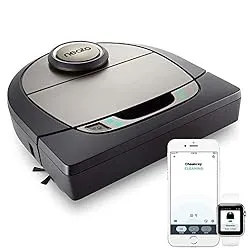
Great value for money
D-shape is good for getting in to corners
Lidar navigation uses lasers to map your home
Quite loud
Interface not as intuitive as other high end vacuums
The Neato D7 has stood the test of time and despite being a few years old, it is still a great affordable alternative to the S9. Neato were using D-shaped robot vacuums long before Roomba cottoned on and used the shape for their top S9 model.
The D7 has full mapping capability using its lidar sensors, if you know anything about the way robot vacuums work, you’ll know that this is more accurate at mapping the room than visual cameras and means it can work easily in the dark, however sometimes it’s not as great as manoeuvring around objects in its path.
It has the ability to use up to three floor plans which are stored in the app. You can segment your rooms and choose higher frequency for rooms that need it. The only real downsides are the loud noise when cleaning and the fact that interface isn’t quite as smooth as iRobot, but it still does the job and is great value for money.